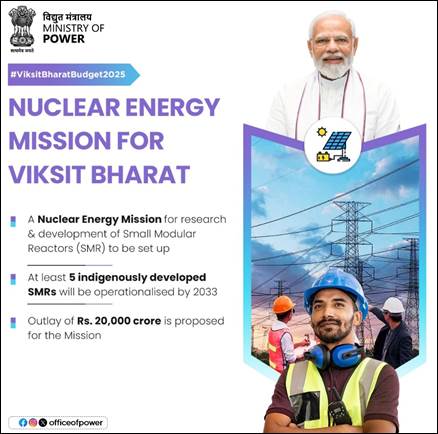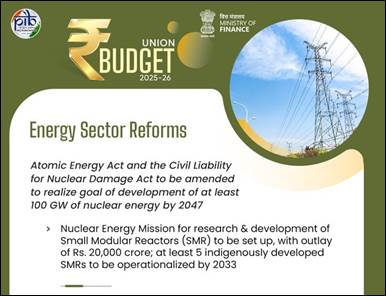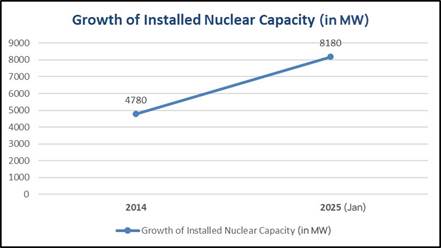The Union Budget 2025-26 outlines a significant push towards nuclear energy as part of India’s long-term energy transition strategy.
The government has set an ambitious target of 100 GW nuclear power capacity by 2047, positioning nuclear energy as a major pillar in India’s energy mix. This development aligns with the broader objectives of Viksit Bharat, ensuring energy reliability and reducing dependency on fossil fuels. To achieve this goal, strategic policy interventions and infrastructure investments are being undertaken, with an emphasis on indigenous nuclear technology and public-private collaborations.
Recognizing nuclear power as a critical component for achieving energy security and sustainability, the government has introduced the Nuclear Energy Mission for Viksit Bharat. This initiative aims to enhance domestic nuclear capabilities, promote private sector participation, and accelerate the deployment of advanced nuclear technologies such as Small Modular Reactors (SMRs).
Small Modular Reactors (SMRs) and R&D Initiatives
A key highlight of the Union Budget 2025-26 is the launch of a Nuclear Energy Mission, which is focused on research and development (R&D) of Small Modular Reactors (SMRs). The government has allocated ₹20,000 crore for this initiative, aiming to develop at least five indigenously designed and operational SMRs by 2033.
Nuclear Energy Mission for Viksit Bharat
To facilitate the implementation of the Nuclear Energy Mission, amendments to the Atomic Energy Act and the Civil Liability for Nuclear Damage Act will be taken up by the parliament. These amendments are expected to encourage private sector investments in nuclear power projects.
These legislative changes are expected to create a more conducive environment for investment and innovation in the nuclear sector. The mission aligns with India’s commitment to achieving 100 GW of nuclear energy capacity by 2047, a milestone deemed essential for reducing carbon emissions and meeting future energy demands. As of January 30, 2025, India’s nuclear capacity is 8180 MW.
The government will enter into partnerships with the private sector with the motive of:
- Setting up Bharat Small Reactors,
- Research & development of Bharat Small Modular Reactor, and
- Research & development of newer technologies for nuclear energy.
Bharat Small Reactors
The government is actively expanding its nuclear energy sector by developing Bharat Small Reactors (BSRs) and exploring partnerships with the private sector. BSRs are 220 MW Pressurized Heavy Water Reactors (PHWRs) with a proven safety and performance record. These reactors are being upgraded to reduce land requirements, making them suitable for deployment near industries such as steel, aluminium, and metals, serving as captive power plants to aid in decarbonization efforts.
The plan involves private entities providing land, cooling water, and capital, while the Nuclear Power Corporation of India Limited (NPCIL) handles design, quality assurance, and operation and maintenance, all within the existing legal framework. This initiative aligns with India’s commitment to achieving 500 GW of non-fossil fuel-based energy generation by 2030 and meeting 50% of its energy requirements from renewable energy by 2030, as pledged at the COP26 Summit in Glasgow in 2021.
In addition to BSRs, the Bhabha Atomic Research Centre (BARC) is developing Small Modular Reactors (SMRs) for repurposing retiring coal-based power plants and meeting power needs in remote locations. The Department of Atomic Energy (DAE) also plans to introduce new nuclear reactors, including high-temperature gas-cooled reactors for hydrogen co-generation and molten salt reactors aimed at utilizing India’s abundant thorium resources.
This strategic move signifies India’s dedication to reducing carbon emissions and enhancing its civil nuclear energy program, with private sector participation playing a crucial role within the bounds of Indian laws and regulations.
Bharat Small Modular Reactors
India is actively exploring Small Modular Reactors (SMRs) as a crucial part of its energy transition strategy, aiming to achieve net-zero emissions while ensuring energy security. SMRs, are advanced nuclear reactors with a power generation capacity ranging from less than 30 MWe to 300+ MWe, providing a flexible, scalable, and cost-effective alternative to conventional large nuclear reactors. Given India’s growing energy demands and the need for reliable, low-carbon power, SMRs can play a transformative role in complementing renewable energy sources and stabilizing the grid. Their modular design allows for factory-based manufacturing, reducing construction timelines and costs, and making them suitable for both on-grid and off-grid applications, including deployment in remote locations.
India’s expertise in Pressurized Heavy Water Reactors (PHWRs) provides a strong foundation for the development and deployment of indigenous SMR designs. By integrating SMRs into its energy mix, India can address land constraints, reduce dependence on fossil fuels, and enhance its ability to meet international climate commitments under the Paris Agreement (2015) which India ratified in October 2016.
Government Initiatives for Enhancing India’s Nuclear Capacity
India is actively enhancing its nuclear power capacity to meet growing energy demands and achieve environmental goals. The government has initiated steps to increase nuclear power capacity from the current 8,180 MW to 22,480 MW by 2031-32. This expansion includes the construction and commissioning of ten reactors, totalling 8,000 MW, across Gujarat, Rajasthan, Tamil Nadu, Haryana, Karnataka, and Madhya Pradesh. Additionally, pre-project activities for ten more reactors have commenced, with plans for progressive completion by 2031-32. Further, the government accorded in-principle approval to set up a 6 x 1208 MW nuclear power plant in cooperation with the USA at Kovvada in Srikakulam district in the state of Andhra Pradesh.
A significant milestone was achieved on September 19, 2024, when the Rajasthan Atomic Power Project’s Unit-7 (RAPP-7), one of the country’s largest and third indigenous nuclear reactors, reached criticality, marking the beginning of controlled fission chain reaction. This event signifies India’s growing capability in building and operating indigenous nuclear reactors, contributing to a future powered by homegrown technology.
Safety remains a cornerstone of India’s nuclear energy policy. India’s nuclear power plants operate with stringent safety protocols and international oversight. The radiation levels at Indian nuclear facilities are consistently well below global benchmarks, underscoring the country’s commitment to secure and sustainable nuclear energy. These efforts align with India’s broader strategy to provide clean and reliable energy, contributing to long-term energy security and environmental sustainability.
Recent Developments in Nuclear Energy in India
- A significant discovery of new deposits in India’s oldest Uranium Mine, the Jaduguda Mines, has been made in and around the existing mine lease area. This will increase the life of an otherwise depleting mine by more than fifty years.
- The first two units of the indigenous 700 MWe PHWR at Kakrapar, Gujarat (KAPS – 3 & 4) have started commercial operation in FY 2023-24.
- Closed fuel cycle being the cornerstone of the Indian nuclear power program, the country’s first Prototype Fast Breeder Reactor (PFBR 500 Mwe) achieved many of the milestones in 2024, viz., Primary Sodium filling in the Main Vessel, purification of the filled sodium and commissioning of all the four Sodium pumps (2 Primary Sodium Pumps & 2 Secondary Sodium Pumps). Core loading commenced with the loading of the first reactor control rod on 4th March 2024.
- NPCIL and National Thermal Power Corporation (NTPC) have signed a supplementary Joint Venture agreement to develop nuclear power facilities in the country. The JV named ASHVINI will function within the existing legal framework of the Atomic Energy Act 1962 (amended in 2015) and will build, own, and operate nuclear power plants, including the upcoming 4×700 MWe PHWR Mahi-Banswara Rajasthan Atomic Power Project.
The provisions for nuclear power in the Union Budget 2025-26 mark a transformative shift in India’s energy landscape. By promoting nuclear energy as a sustainable, scalable, and secure power source, the government aims to bolster energy security and meet the nation’s long-term economic and environmental goals. The Nuclear Energy Mission for Viksit Bharat is poised to accelerate nuclear power development, positioning India as a global leader in advanced nuclear technology by 2047.











